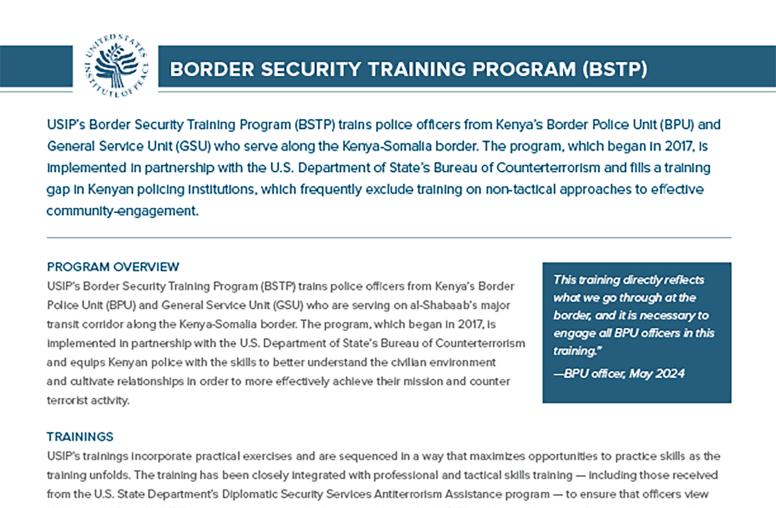Elections and Violent Conflict in Kenya: Making Prevention Stick
To prevent a recurrence of the widespread violence that left 1,100 dead and 650,000 displaced in the aftermath of the December 2007 Kenyan elections, Kenya and the broader international community initiated a multifaceted peacebuilding effort in the lead-up to the country’s March 2013 elections.
When election day passed without widespread violence, international and regional actors lauded the electoral process as “peaceful” and “successful.” But the Kenyan population express a more qualified view about the elections and point to palpable tension, fear, and anxiety felt throughout the country to explain the perceived stability at the surface. To test the international success narrative, this report draws on a series of dialogues conducted across ten counties in Kenya. The dialogues were designed to understand how ordinary Kenyans experienced the elections, identify the factors that constrained behavior and prevented mass violence, and determine whether relevant lessons can be drawn not just for Kenya’s 2017 elections but also for upcoming elections around the world.
Summary
- International election observers and diplomats celebrated the March 2013 Kenyan general elections as “peaceful” and “successful.” But Kenyans disagree. The local population described the electoral experience as one of “tense calm” or “unstable peace.” These contrasting— even contradictory—views raise questions about the legitimacy of the success narrative.
- The 2013 general elections proceeded without mass violence, a significant advance in light of the country’s recent electoral history. But Kenyan citizens were hesitant to credit peacebuilding efforts for this relative success and expressed concern about the high levels of ethnic tension, hate speech, voter bribery, and intimidation throughout the electoral period, both in areas previously hard hit by violence and in areas where electoral violence was unprecedented.
- Narratives of fear and memory were the dominant explanations for why the country averted mass violence. Kenyans still recall the devastating impact of previous episodes of conflict, particularly the 2007–08 postelection violence. Those memories reduced the appeal of violence and encouraged restraint during the 2013 elections.
- The notion of Kenya as a ticking time bomb is prevalent within the local population. There is a widespread expectation that violent conflict could erupt even before the 2017 elections as the long-standing grievances that fueled violence in 2007–08, and were merely suppressed during the 2013 general elections, have not been resolved. Mombasa, Marsabit, and Bungoma stand out among the counties where dialogues were conducted as facing a particularly high risk of imminent violent conflict.
- The withdrawal of international assistance further increases the risk of future violence, particularly when civil society is increasingly under threat and operating within a shrinking space.
- As related but distinct fields of peacebuilding practice, atrocity prevention, electoral violence prevention, and conflict prevention remain stovepiped and require further integration. Convening practitioners from these fields in joint conflict assessments and adjusting the annual funding cycles of international actors, including the U.S. government, to facilitate election programs that address root causes of violent political conflict are tangible first steps.
- Experienced peacebuilding organizations should offer technical assistance to election administrators and democracy practitioners, including best practices on mitigating triggers for election violence and addressing underlying drivers of widespread political violence.
About the Report
This report aims to complement existing postelection analysis by examining local experiences of Kenya’s 2013 general elections, evaluating the various factors that worked to prevent widespread violent conflict and assessing the sustainability of the “relative calm” achieved during the electoral period. The United States Institute of Peace (USIP) and its partners, the Constitutional Reform and Education Consortium (CRECO) and the Interparty Youth Forum (IPYF), convened citizen dialogues and conducted key informant interviews to evaluate preventive efforts around the March 2013 general elections in Kenya. Through qualitative research, USIP and its partners collected original data from November to mid-December 2013 in ten carefully selected counties across Kenya—Marsabit, Embu, Nyeri, Nakuru, Uasin Gishu, Bungoma, Kisumu, Nyamira, Mombasa, and Nairobi. The citizen views collected offer valuable insights into popular attitudes and the factors that influenced behavior during the electoral process. This report is part of USIP’s broader commitment to peace in the Horn of Africa and thematic focus on preventing electoral violence.
About the Authors
The lead author, Claire Elder, worked as a consultant with International Crisis Group’s Horn of Africa Project in Nairobi, Kenya, where she monitored and researched the 2013 Kenyan general elections. Susan Stigant is a senior program officer in USIP’s Center for Governance, Law, and Society. Jonas Claes is a senior program officer in USIP’s Center for Applied Research on Conflict. The authors thank Kawive Wambua, a key member of the project team who contributed to the project design and documentation.



